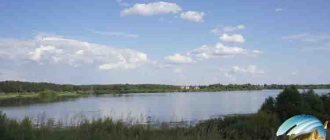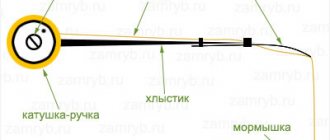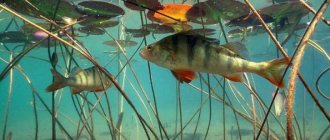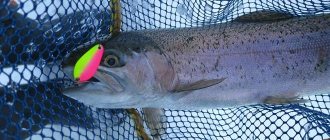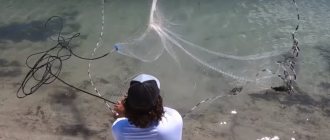So she settled them in the reservoirs of the northern regions of Russia. The climate here is harsh both in summer and winter. And this can be safely counted as an exam for beginners, having decided to get to know the polar fish better.
This is where the most respectable trophies of pike, burbot, whitefish, char, and perch live. Fishermen say that in some lakes there were pikes almost 3 meters long! And in one story, when such a “monster” landed on a spoon, the spinner was forced to simply cut off the fishing line, since his own boat did not give him hope for a successful outcome of this meeting.
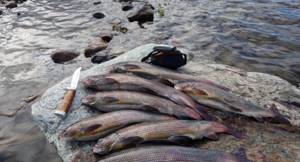
The good news is that you can get acquainted with the trophies throughout the year. Mostly fishing tourists come to the Ob near Salekhard, and also fish in the Poluy tributary. Whitefish are what else is worth coming here for. Freshly caught and cooked muksun will give odds to any restaurant sterlet!
Features of fishing in the Yamalo-Nenets Autonomous Okrug
People go to Yamal to buy whitefish. It is here that approximately 70% of such fish on the planet are preserved. The most valuable whitefish fish is muksun. You can catch salmon or pike in numerous reservoirs in the district. The familiar pike, perch and crucian carp are found here. Conditions in the region's reservoirs are optimal for the rapid growth of pike, thanks to which you can catch really large specimens of this fish with a spinning rod, reaching 45 kg in weight. There are so many trophy specimens of pike that local fishermen usually release pike weighing 10 kg to “feed their sides.” If you decide to organize your vacation yourself, it is advisable to familiarize yourself with the fishing rules in the region in advance, choose a suitable body of water, and find out whether fishing in this body of water is free or requires purchasing a license. Tour operators that organize fishing tours can offer amateur fishermen optimal timing and duration of trips to the rivers, lakes and reservoirs of the Yamalo-Nenets Autonomous Okrug.
Features of fishing in Yamal
On the territory of the district, in the basin of the Ob and Ob Bay, there is the largest herd of whitefish in Russia - about 70% of their all-Russian population. Valuable commercial fish are caught in the reservoirs: sterlet, muksun, and nelma. Fishing is a vital sector of agro-industrial production, providing the traditional diet of the northern peoples. The basis of the fishing industry in the Autonomous Okrug consists of 9 enterprises engaged in fish production. The development of the industry is carried out along the path of creating a unified fishing industry complex, which includes fish production, its processing and further marketing in the form of final processed products in the form of canned food and, of course, balyk products. The fishery reservoirs of the Yamal-Nenets Autonomous Okrug: rivers, lakes, sea estuaries, lips and bays represent a unique wealth of Russia, where large self-reproducing reserves of the most valuable whitefish are concentrated. The abundance of food in lakes and floodplains of rivers, sufficient conditions for spawning are favorable for the reproduction and feeding of fish. More than forty species of fish are found in the district's water bodies, thirty of which are of commercial importance. Sturgeon live in the Ob River and Ob Bay. Another representative of the sturgeon, the sterlet, inhabits the floodplain-river system of the Lower Ob. In the upper reaches of the rivers: Sev. Sosva, Synya, Voykara, Taz, Khudosey, the taimen is preserved, which, together with the Arctic char that lives in the large lakes of Yamal and Gydan, represents a genus of the salmon family. The greatest species diversity is characteristic of the whitefish family. For example, the Arctic omul, whose distribution area is confined to the Gydan Bay and the coast of the Kara Sea near the Gydan Peninsula. The basis of the most valuable whitefishes are semi-anadromous species: nelma, muksun, peled (cheese cheese), whitefish, whitefish, vendace (Ob herring), which from the Ob and Taz bays annually rise to spawn in the rivers of the district: Ob, Northern Sosva , Sob, Synya, Taz, Pur, Shchuchya, Messoyakha and others. A small whitefish, but unsurpassed in taste, the tugun (Sosva herring), does not make large migrations and lives permanently in Northern Sosva. The total catches of valuable whitefish in the reservoirs of Yamal reach 5-7 thousand tons per year, which is half of their catch in the reservoirs of Russia. The Gulf of Ob, which is a unique feeding reservoir for juveniles and spawners of sturgeon, nelma, muksun, peled, whitefish, whitefish, and vendace, is home to large herds of ruffe and smelt, which intensely compete with valuable fish species. In addition to the ruffe, the perch family in the district's water bodies is represented by perch and pike perch. Pike perch penetrated into the southern part of the Ob Bay from the Novosibirsk reservoir down the river. Ob. In the rivers of the district, pike reaching 1 m in length or more is common. There are significant reserves of various carp fish - dace, roach, ide, tench, crucian carp (golden and silver), which are objects of consumer fishing. The carp family is also represented by non-commercial fish - three species of minnows and gudgeon. This family was replenished by bream and verkhovka, which ended up in the river. Ob with the help of a person. Burbot is of significant importance in industrial fishing, the catches of which are significant and stable.
Fish resources are an important part of renewable biological resources used by humanity since ancient times. Rational management of fisheries must first of all be based on an assessment of the state of exploited fish populations.
Yamal is an area rich in fish resources. Most of the fish are valuable commercial species, which represent an important biological resource that creates the basis for the formation and survival of indigenous peoples of the North. Since the beginning of the 90s of the 20th century, in addition to the indigenous peoples, the fish resources of the Yamal territory began to be very intensively used by the population involved in the development of the gas fields of Yamal.
Various successional changes in freshwater ecosystems occur constantly, both under the influence of climate and under the influence of various types of human activities. Under anthropogenic influence, the speed of processes increases. In the fish production of water bodies, valuable commercial species are being replaced by low-value, non-commercial ones. In order to preserve the number of valuable commercial species, special measures are often necessary, costing huge amounts of money.
Successional changes in the structure of the fish part of the community can be caused by different types of human economic activity: changes in the living conditions of fish; improper fishing practices over a long period, which is considered a stress factor; introduction of new species.
When developing deposits in Yamal, changes in the ichthyofauna occur under the influence of the first two reasons. There are no industrial facilities on the territory of the Polar Urals yet, and all changes in the ichthyofauna occur only as a result of fishing. The route of the Bovanenkovo-Ukhta gas trunkline will pass through Western Yamal and will reach the shore of Baydaratskaya Bay near the mouth of the river. Ngoyuyakha and will cross a number of rivers of the Polar Urals.
When implementing the megaproject “Ural Industrial - Ural Polar”, railway and highway routes will run along the eastern slope of the Ural Mountains and cross the main spawning rivers in spawning areas.
Until now, there has been no specific influence from the gas industry. The damage that has been caused to fish resources over the past 30 years has been practically not taken into account, although stocks of valuable fish have decreased significantly. In the context of a systemic economic crisis, traditional forms of fishing and protection of fish resources were destroyed.
The transformation of Yamal into a huge gas condensate province, which has a decisive role in the energy supply of Russia and Europe, will inevitably lead, already at the initial stages of development, to an even greater reduction in renewable biological resources. And the point is not that certain inevitable changes in the environment will occur, but that the fishing pressure on populations whose numbers have already been reduced will increase.
Given the critical state of many fish populations living in Yamal, it is extremely necessary to generalize fundamental knowledge and factual information on fish resources, including data on distribution, abundance, size-age and sex structure. Generalization of long-term data will serve to rationalize the use of biological resources and revive the fishery potential of the Yamal rivers.
Despite the great theoretical and practical significance of the hydrobiological study of Yamal, until recently they have not received due attention. In terms of ichthyology, the tributaries of the Lower Ob are the most studied.
Our work shows a general picture of the state of fish resources over a vast territory that is of great importance for the existence and reproduction of unique populations of valuable fish species.
Fishes of Yamal
The fish stocks of the Yamal Peninsula are of enormous economic importance. There is an abundance of food-rich reservoirs of various types, a minimum of destructive civilization and gentle poaching; the local population is so small that even by poaching, they cannot destroy an excessive amount of valuable fish. Very good conditions for spawning grounds: there are no dams or hydroelectric power plants on or above them. In general, fish heaven in its purest form. About 40 species of fish are found in the reservoirs, more than 30 of which are valuable commercial fish.
The rivers of the North have the most fish among all the rivers in Russia. Of these, the richest in fish is the Ob. The main wealth of the Ob is whitefish. There are no such numbers of whitefish anywhere in the world. Every year, 10-11 thousand tons of vendace, peled, muksun, whitefish, whitefish, tugun, omul and nelma are caught here, which is almost half of the total whitefish catch in Russia or a third of the world. The Yamalo-Nenets Autonomous Okrug (Yamalo-Nenets Autonomous Okrug) produces more marketable fish than the entire Eastern Siberia.
Fish plays a huge role in the livelihoods of the indigenous peoples of the North. The lifestyle of the Khanty and Nenets is largely focused on fishing and hunting. There is hope that fishing tourism will also appear. In the reservoirs of Yamal there are both marine fish and freshwater fish (for which, in fact, fishing tourists go).
The fresh waters of the Yamal-Nenets Autonomous Okrug are home to 36 species of fish, of which 26 are commercial (or of interest to sports fishermen). According to biology, fish are divided into semi-anadromous, mixed-water (or euryhaline) and aquatic.
Fishing in the Yamalo-Nenets Autonomous Okrug
The habitat of semi-anadromous fish includes rivers with tributaries and the pre-estuary desalinated zone. These include mainly whitefish. The mixed-water form of fish, living in both fresh and brackish waters, is represented by stickleback, smelt and some other species. Low-water fish are inhabitants of fresh waters that do not make long migrations, lake (lake minnow) and lake-river (pike, ruffe, minnow, taimen, grayling), which are found in both flowing and stagnant reservoirs. Most fish lead a migratory lifestyle.
The fewest fish live in the rivers and lakes of Northern Yamal - about seven to eight species. Other fish are also of commercial importance in the Ob, including sturgeon, pike, burbot, and ide.
On the vast territory of Yamal, in its different regions and reservoirs, different situations are observed with fish of the same species. Thus, the number of taimen is sharply declining in the Synya, Voykar, Sob rivers and in the rivers of Southern Yamal. And in its other parts and rivers the population of this fish is stable and fishing is allowed; in the upper reaches of the Taz and in Khudosey it is very widespread and numerous, and you can catch it there. But grayling can only be found in the mountain rivers of the Urals, in the mountain tributaries of the Taz and the upper reaches of the Shchuchya River. It is not found in other reservoirs of Yamal. So, before you go seven miles to catch fish, it’s worth developing a detailed route, understanding what exactly you want to see and how and what kind of fish you plan to catch.
The ideal time for local fishing is August - September: there are no midges and mosquitoes, the days are warm, and the nights are clear and unusually starry. Among the lower representatives of fish-like species, you can catch lampreys in these parts: Siberian and (much less often) Pacific Japanese.
Of the sturgeon species, Siberian sterlet and sturgeon live here - valuable commercial fish and objects of commercial sturgeon farming. Both fish are included in the Red Book of the Russian Federation and the IUCN Red Book. So it is prohibited to catch sturgeon here (as well as in the reservoirs of other regions).
Although there are not many types of salmon fish here, their quantity and quality are beyond praise. Arctic char can stand so densely in Yamal lakes that they resemble reddish logs that can be picked up with bare hands. This fish is absolutely unafraid, and even a novice angler can catch it. However, in some reservoirs (Shchuchye and Baydaratskaya Bay) fishing for it is prohibited, since it is included in the Red Book of the Yamal-Nenets Autonomous Okrug. Taimen, listed in the Red Book, cannot be caught here either. There are not very many pink salmon here; it is better to go to the Far East for it.
Among the closest relatives of salmon, which constitute the main and most unique fish wealth of this peninsula, are fish of the whitefish family.
There are a total of 15 species of whitefish in this region. The numbers of some native whitefish in many bodies of water are remarkable. Let's start with nelma. This is a valuable commercial species, however, the number of this fish is sharply declining. Now nelma is listed in the Red Book. The next whitefish is muksun. Anyone who has tasted it at least once will never forget it. This is a valuable fish, but unfortunately, its numbers are also declining. Except for the Mordyyakha River. You can catch muksun everywhere here. Valuable commercial species include whitefish such as broad whitefish, whitefish, peled, Siberian vendace, and tugun (except for the Red Book tugun of the Sob River). The last valuable local whitefish is the Arctic omul. Unfortunately, lately it has also become less numerous. From the grayling family, Siberian grayling is found here, which is of local commercial importance. Fishing in Salekhard
Grayling in mountain rivers is simply magnificent. As local fishermen say, at certain times of the year this delicious fish is caught almost with a bare hook. The lower you go down any mountain river, the smaller the grayling becomes; however, the catches do not suffer from this, since its quantity increases.
Of the smelt species, you can find Asian smelt (a valuable commercial fish) and smallmouth smelt, which is mainly used as food for cats and is not very abundant in water bodies.
Common pike is a valuable commercial species for this region. The weight of the average local pike is up to 6 kg. It is not uncommon to come across 25-kilogram individuals. The pike constantly stands in the same places. It is very easy to catch - the fish is trusting and not shy.
Not as exotic as whitefish or lampreys are simple carp fish. There are extremely many species of this family (Siberian roach, Siberian dace, ide, golden carp and bream). Moreover, due to their gigantic size and quantity for the species, they are commercially available. Some local cyprinids are not so valuable - these are minnows (Chekanskogo, common and lake), Siberian gudgeon and others.
A very large and abundant fish is the local burbot. There are a lot of large perch, pike perch and ruff in the reservoirs. There are a lot of sculpin, nine-spined stickleback, loaches and other small common fish.
Of the marine species, numerous interesting ones are cod and navaga (cod fish) and polar flounder. This region is remarkable not only for its fish and animals, but also for its extremely friendly, hospitable and open people who always welcome kind guests. You need to prepare well for the trip, develop a route, agree with the host party and find out all the details and features of your stay there. Then your first trip to Yamal will definitely be followed by a second and subsequent ones.
Commercial value
Commercial fish are those species of fish in which the state is interested in catching. Enterprises put up their catch for sale, and part of it goes for processing. Medicines and fertilizers are made from raw materials, and industrial fats are produced.
The volume of production is set by the state. They catch fish that live at shallow depths. Fishing ships go to the habitats of muksun and salmon. Some salmon live in the Ob and Irtysh, so fishing is carried out not only in the Arctic Ocean, but also in the river systems of Russia.
Northern fish is different in that its meat contains a large amount of fat, but its composition is not similar to the fat of the inhabitants of the southern seas. Fatty acids are unsaturated, so at low temperatures they do not crystallize, but remain in a form that retains nutrients as much as possible.
Omega-3 and large amounts of protein (much higher than that found in meat) are the hallmarks of the inhabitants of northern waters. Eating such fish reduces the likelihood of rheumatoid arthritis, heart and vascular diseases by 50%. This is an effective anti-inflammatory drug that has a beneficial effect on the brain and helps prolong life.
see also
|
|
|
